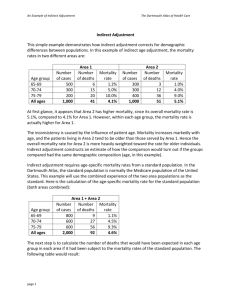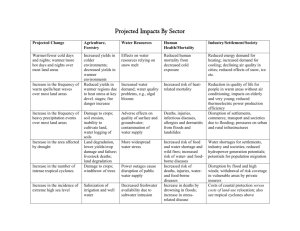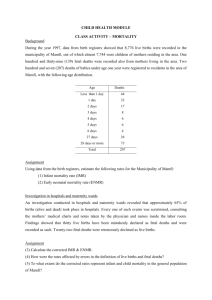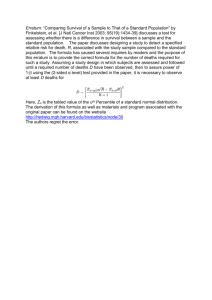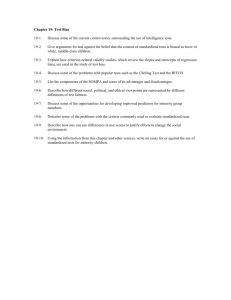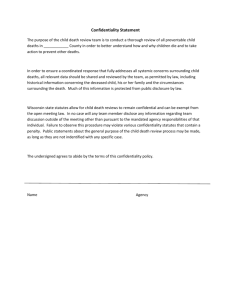AGE-ADJUSTED DEATH RATE (INDIRECT METHOD)
advertisement
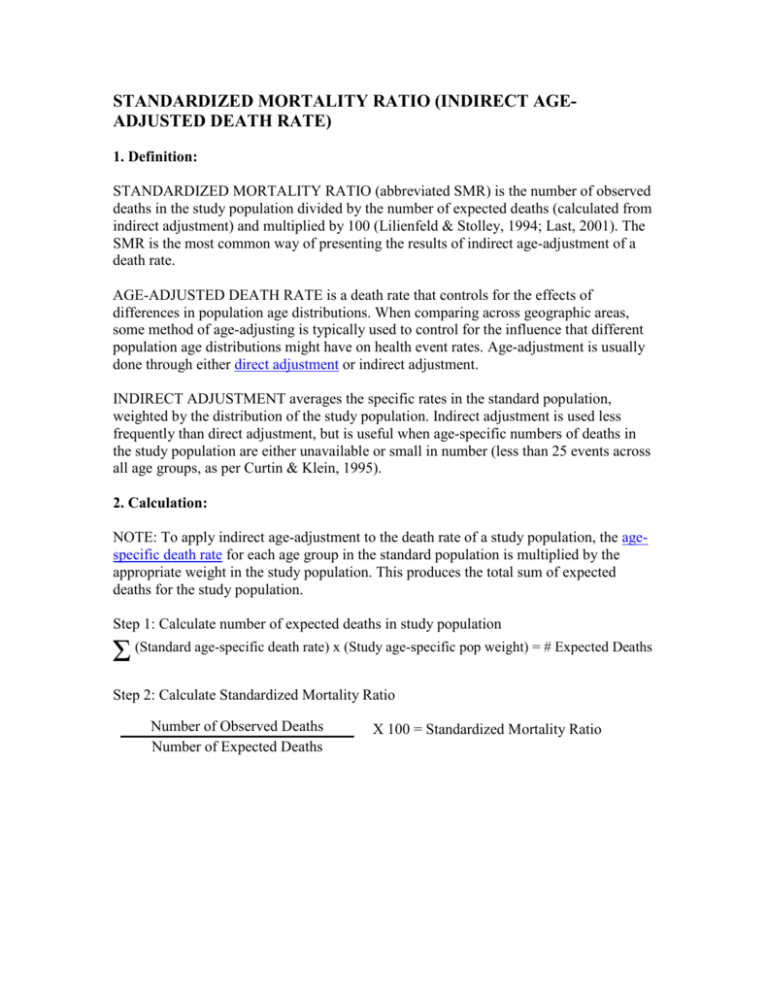
STANDARDIZED MORTALITY RATIO (INDIRECT AGEADJUSTED DEATH RATE) 1. Definition: STANDARDIZED MORTALITY RATIO (abbreviated SMR) is the number of observed deaths in the study population divided by the number of expected deaths (calculated from indirect adjustment) and multiplied by 100 (Lilienfeld & Stolley, 1994; Last, 2001). The SMR is the most common way of presenting the results of indirect age-adjustment of a death rate. AGE-ADJUSTED DEATH RATE is a death rate that controls for the effects of differences in population age distributions. When comparing across geographic areas, some method of age-adjusting is typically used to control for the influence that different population age distributions might have on health event rates. Age-adjustment is usually done through either direct adjustment or indirect adjustment. INDIRECT ADJUSTMENT averages the specific rates in the standard population, weighted by the distribution of the study population. Indirect adjustment is used less frequently than direct adjustment, but is useful when age-specific numbers of deaths in the study population are either unavailable or small in number (less than 25 events across all age groups, as per Curtin & Klein, 1995). 2. Calculation: NOTE: To apply indirect age-adjustment to the death rate of a study population, the agespecific death rate for each age group in the standard population is multiplied by the appropriate weight in the study population. This produces the total sum of expected deaths for the study population. Step 1: Calculate number of expected deaths in study population (Standard age-specific death rate) x (Study age-specific pop weight) = # Expected Deaths Σ Step 2: Calculate Standardized Mortality Ratio Number of Observed Deaths Number of Expected Deaths X 100 = Standardized Mortality Ratio 3. Examples: The following calculates the SMR for Los Angeles County, using California death rates as the standard for comparison. Age Standard Population Study Expected Category Death Rate* Population** Deaths <1 5.3 154,585 8 1-4 25.6 607,984 156 5-14 14.1 1,585,503 224 15-24 69.2 1,440,136 997 25-34 83.6 1,528,427 1,278 35-44 156.5 1,616,982 2,531 45-54 373.2 1,337,298 4,991 55-64 770.5 872,216 6,720 65-74 1822.1 527,629 9,614 75-84 4626.5 365,602 16,915 85+ 11873.4 138,471 16,441 Total 59,875 59,153 Observed Deaths** 59,875 Expected Deaths X 100 = 98.8 Standardized Mortality Ratio * from Vital Statistics of California 2004 (rates are per 100,000 population) ** from Mortality in Los Angeles County 2004 Additional links to State/National websites with calculation and/or definition: • Standardized Mortality Ratio, Pennsylvania Department of Health 4. Technical Notes: • • • A SMR of above 100 means the number of observed deaths is greater than what would be expected if the study population had the same probability of dying as the standard population, while a SMR of below 100 means the number of observed deaths is less than expected. For indirect adjustment, the SMR is usually quoted in studies and not the indirect standardized rate, which is calculated from the product of the SMR and the crude rate of the standard population and rarely used as a stand alone measure. If indirectly standardized rates are used, it is technically appropriate to compare indirect standardized rates only with the rate in the standard population, not with each other. Indirect standardized rates usually appear as rates per 100,000 population. Although age-adjustment may be used with broad population age groups, such as adults (e.g., age 18+), it is not necessary (or meaningful) to age-adjust data for smaller age groups (e.g., age 18-24). • • • • In order to determine if there is a significantly higher or lower number of observed cases than expected, it is necessary to compute a standard error or confidence intervals (usually at 95%) for the SMR. See Confidence Intervals and Significance Testing for a Standardized Ratio, Pennsylvania Department of Health. Age adjustment is not appropriate if the age-specific death rates in the population of interest do not have a consistent relationship. For example, if death rates among younger persons are increasing over time, but death rates among older persons are decreasing over time, you would not want to age-adjust rates across years. For further technical notes on age adjustment in general, see direct adjustment. The Division of Vital Statistics (DVS) at NCHS follows standards for use of the terms “death rate” and “mortality rate” in naming and reporting common vital statistics rates for deaths. The NAPHSIS standard measures shown here follow the DVS standards, primarily to maintain consistency with DVS for naming conventions. Please note that states/registration areas and other federal government organizations within and outside NCHS/CDC may not follow the DVS standards when naming and reporting death/mortality rates. 5. References: California Department of Health Services, Office of Health Information and Research, Vital Statistics Section. Vital Statistics of California 2004. June 2007. Curtin, LR, Klein, RJ. Direct Standardization (Age-Adjusted Death Rates). Statistical notes; no.6. Hyattsville, Maryland: National Center for Health Statistics. March 1995. Last, JM. A Dictionary of Epidemiology, 4th Ed. Oxford University Press, 2001. Lilienfeld, DE and Stolley, PD. Foundations of Epidemiology, 3rd Ed. Oxford University Press, 1994. Los Angeles County Department of Public Health, Office of Health Assessment and Epidemiology. Mortality in Los Angeles County 2004: Leading causes of death and premature death. July 2007. (09/15/09)

